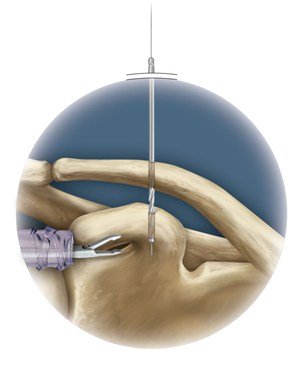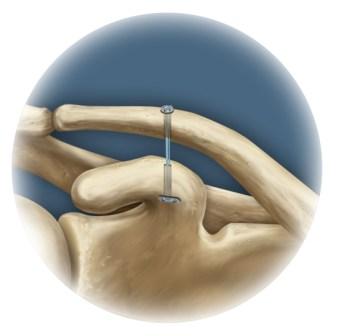Anatomy
The Acromioclavicular (AC) joint is located at the end of the clavicle (collar bone) at the top of the shoulder.
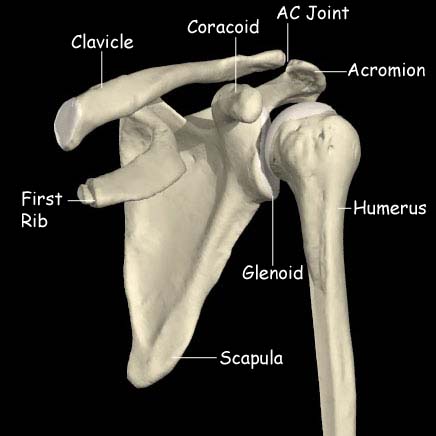
Dislocation
Dislocation of the joint usually occurs following a fall onto the hand or elbow or onto the point of the shoulder. More commonly the joint partially dislocates, this is known as a subluxation.
The Ligaments holding the clavicle down to the coracoid (the coraco-clavicular ligaments) are torn as wells the ligaments from the clavicle to the acromion (the Acromio-clavicular ligaments)
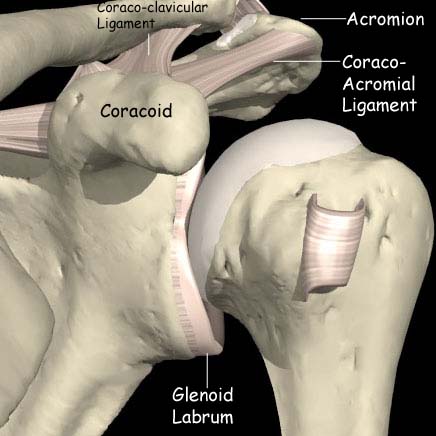
What are the signs and symptoms?
Severe pain is felt over the shoulder and any attempt to lift the arm up or carry anything makes this worse. A bump may be felt over the top of the shoulder. This is usually very tender.
How is the diagnosis made?
The doctor will listen to the description of events and examine the shoulder. X-Rays will also be taken. Occasionally the patient will be asked to carry a weight in the affected hand during the X-Ray. This is designed to stress the joint and make the dislocation more obvious.
What is the initial treatment?
Injury to the AC Joint can be classified into 6 grades
Grades 1 & 2 are essentially sprains. These hurt but with have little deformity.
Grade 3 dislocations have some deformity but are usually stable and can be treated like the Grades 1 & 2.
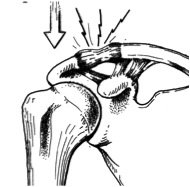
Grade 1 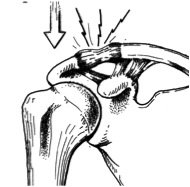
Grade 2 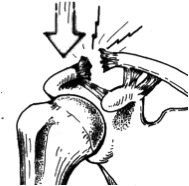
Grade 3
These require only a sling to rest the joint for a few days followed by exercises to recover the range of movement. It takes about 6 weeks for the discomfort to settle and a bump will always remain but otherwise they heal well.
Work and sports can be resumed as soon as comfort allows and there is no bar to contact sports in the future.
The more severe grades (4, 5 and 6) will require surgery to put the joint back together and to repair the torn ligaments.
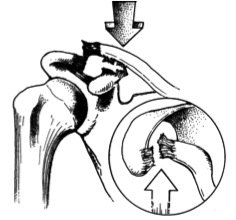
Grade 4 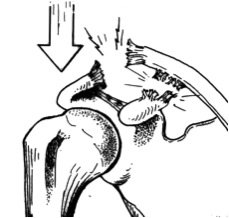
Grade 5 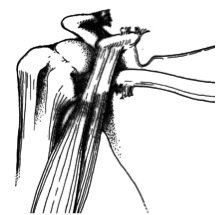
Grade 6
If the decision is made that the joint requires surgery it is recommended that this is undertaken within 4 weeks of injury.
Prof Tennent’s preferred technique is the Tightrope Technique which was developed by Prof. Tennent in 2004 and has been performed over 100,000 times worldwide.
Video of the Arthroscopic ACJ Tightrope Surgical Technique
Animation of the Arthroscopic ACJ Tightrope Technique
In delayed cases the Tightrope is supplemented with transfer of the coraco-acromial ligament, the “Weaver-Dunn” procedure.
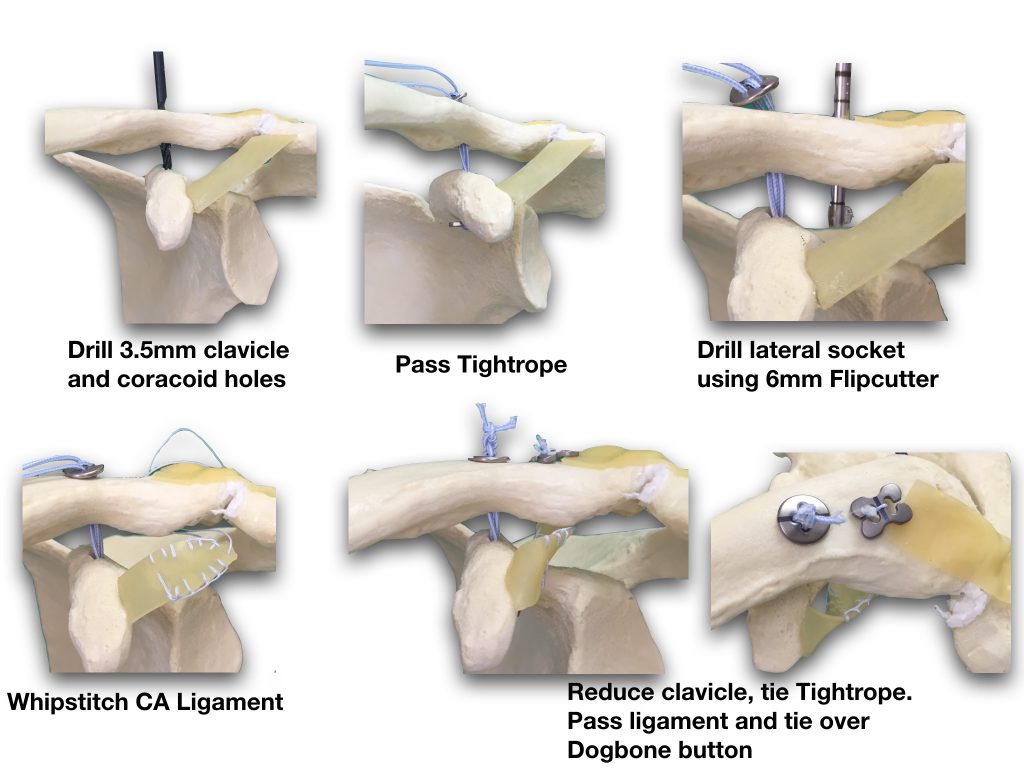
Procedure
A 5 cm incision is made along the underside of the collarbone. The joint is placed in the correct position and the Tightrope device is then passed through the 2 holes and secured, placing the clavicle back in the correct position.
Occasionally it is necessary to reinforce the ligaments with additional sutures.
In chronic cases the Coraco-acromial ligament is moved and fastened into the clavicle to provide additional biological repair and the ligaments around the joint itself are also reinforced.
Wound Closure
A dissolving stitches is used for the incision.
Small butterfly paper stitches will be used to close the wounds. A Tegaderm waterproof dressing will be placed over the top of the paper stitches.
Pain relief
The anaesthetist will discuss a nerve block which will be administered after you are asleep, this means that you will wake up with no pain in the shoulder but the arm will feel numb for up to 12 hours. You will be prescribed painkillers to start taking when you get home and we encourage you to take these regularly for at least the first few days. There will be some discomfort but this settles quite rapidly and ice packs can be used in addition if you wish.
Wound care
The dressings will be changed before you go home and these can be left alone until they are removed. Typically they can be removed 10 days after surgery just by peeling them off and you do not need to visit the doctor for this.
The dressings are showerproof and you will be given some spares in case they start to peel off.
Rehabilitation after surgery
You will wake up with a sling on your arm. It is ESSENTIAL that you wear this as instructed.

You should wear the sling for the first 4 weeks.
It can be removed for washing and dressing and if the elbow is supported (e.g. at a desk)
Keep the elbow and wrist moving to avoid stiffness.
4 weeks following the surgery you can start physiotherapy to work on regaining the range of motion and strengthening can start at 3 months.
Surgical Risks
Every operation has a degree of risk. It is important that you are aware of these risks before you agree to proceed with your operation.
If you decide not to proceed with surgery there is a possibility that the symptoms will settle on their own but they may continue and they may get worse. You will not damage the shoulder if you decide not to proceed with surgery.
The most common or significant risks are outlined below. A risk of 0.1% means that 1 in 1000 people will suffer the complication
- Failure of the procedure to relieve symptoms: 5%
- Superficial Infection (requiring antibiotics): 0.16%
- Deep Infection (requiring further surgery): 0.02%
- PE (Pulmonary Embolus) (Blood clot in the lung): 0.13% – Blood thinning medication is required for several months. Can rarely result in death.
- DVT (Deep Vein Thrombosis) (Blood clot in the leg): 0.14% – Blood thinning medication is required for several months. Can lead to PE
- Nerve Injury: 0.01% – Usually temporary. Can cause weakness around the shoulder with loss of function and rarely can be permanent.
- Heart attack: 0.02%
- To put these numbers in perspective
The chance of:- Getting three balls in the UK national lottery: 0.9%
- Needing emergency treatment in the next year after being injured by a can, bottle, or jar: 0.1%
- Death by an accident at home: 0.01%
- For a 50 year old man in good health the 5 year risk of dying is 0.8%
Frequently asked questions
Return to work after surgery
This is very much dependent on the type of work that you do, whether you need to drive to get to work and the type of surgery that you have had done.
You, as the patient, have the best idea of the specific demands that are required of you to do your work safely and effectively.
Having an operation with an anaesthetic often takes more out of people than they would expect. Generally it is probably worth taking at least a week off from your regular work after having had any procedure.
You should discuss expected post-operative recovery and work with the surgeon before your operation.
Driving after surgery
To be able to drive safely you should be capable of actively moving your shoulder without assistance and without damaging the surgical repair. You should be able to react normally to avoid causing injury to yourself or others due to a lack of control.
Typically this is a MINIMUM eight weeks after surgery.
It is a UK requirement that, unless specific dispensation has been granted by the DVLA, a driver uses both arms to control the steering wheel.
It is the responsibility of the driver to ensure that they are in control of the vehicle at all times. They should be able to demonstrate this if stopped by the police.
It is not a requirement to notify the DVLA unless the medical conditions likely to affect safe driving persist for longer than three months after the date of the surgery.
Drivers must not drive under the influence of narcotic medications or within a minimum of 24 hours after an anaesthetic.
You are not allowed to drive one-handed and therefore cannot drive whilst you are in the sling.
There is no precise time after surgery when you can return to driving, it varies from person to person. However, the recommended amount of time that your arm should be in a sling following surgery is the MINIMUM time before considering a return to driving.
